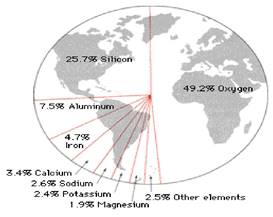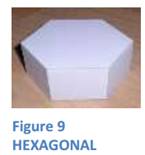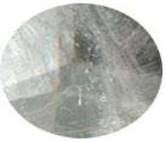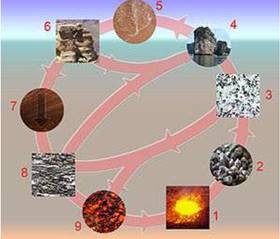
myCBSEguide App
Download the app to get CBSE Sample Papers 2023-24, NCERT Solutions (Revised), Most Important Questions, Previous Year Question Bank, Mock Tests, and Detailed Notes.
Install NowCBSE Geography Chapter 5 Minerals and Rocks class 11 Notes Geography in PDF are available for free download in myCBSEguide mobile app. The best app for CBSE students now provides Minerals and Rocks class 11 Notes Geography latest chapter wise notes for quick preparation of CBSE exams and school based annual examinations. Class 11 Geography notes on Chapter 5 Minerals and Rocks class 11 Notes Geography are also available for download in CBSE Guide website.
CBSE Guide Minerals and Rocks class 11 Notes
CBSE guide notes are the comprehensive notes which covers the latest syllabus of CBSE and NCERT. It includes all the topics given in NCERT class 11 Geography text book. Users can download CBSE guide quick revision notes from myCBSEguide mobile app and my CBSE guide website.
Minerals and Rocks class 11 Notes Geography
Download CBSE class 11th revision notes for Chapter 5 Minerals and Rocks class 11 Notes Geography in PDF format for free. Download revision notes for Minerals and Rocks class 11 Notes Geography and score high in exams. These are the Minerals and Rocks class 11 Notes Geography prepared by team of expert teachers. The revision notes help you revise the whole chapter in minutes. Revising notes in exam days is on of the best tips recommended by teachers during exam days.
Download Revision Notes as PDF
UNIT III
LANDFORMS
CHAPTER-5
Minerals and Rocks class 11 Notes Geography
This unit deals with Minerals, elements, characteristics of minerals such as crystal form cleavage, fracture, lustre, colour, streak, transparency, structure, hardness specific grvity, important minerals such as feldspar, quartz, pyroxene, amphibole, mica, olivine and their characteristics classification of minerals, rocks, igneous, sedimentary, metamorphic rocks rock cycle Minerals found in the crust are in solid form where as in intrior they are in liquid form98% of the crust consist of eight elements
1.oxygen
2. Silicon
3. Aluminium
4. Iron.
5. Calcium
6. Sodium
7. Potassium
8. Magnes the rest is constituted by titanium, hydrogen, phosphorous, manganese, sulphur carbon, nickel & other elements

Table 5.1: The major Elements of the Earth’s Crust
| Sl. No. | Elements | By Weight(%) |
| 1. 2. 3. 4. 5. 6. 7. 8. 9. | Oxygen Silicon Aluminium Iron Calcium Sodium Potassium Magnesium Others | 46.60 27.72 8.13 5.00 3.36 2.83 2.59 2.09 1.41 |
Many elements found in combination with other elements. These substances are called minerals
Mineral: naturally occuring inorganic substance having an orderly atomic structure and a definite chemical composition and physical properties.
It is composed of two or three minerals /single element ex. S,Cu, Ag,Au, Graphite.
There are at least 2000 minerals in the crust. There are at least six mineral groups which form rocks in the crust.
The basic source of all minerals is the hot magma in the interior of the earth. Coal, petroleum and natural gas are organic minerals
PHYSICAL CHARACTERISTICS OF MINERALS
(I) EXTERNAL CRYSTAL FORM: lnternal arrangement of molecules-cube, octahedrons, hexagonal, prisms.




(II) CLEAVAGE: Tendency to break in given direcations producing relatively plane surfaces, it may any direction

FRACTURE: Conchoidal fracture
Obsidian

Conchoidal fracture is a curved breakage that resembles the concentric ripples of a mussel shell. It often occurs in amorphous or fine-grained minerals such as flint, opal or obsidian, but may also occur in crystalline minerals such as quartz. Sub conchoida( fracture is similar to conchoidal fracture, but not as curved. (Note that obsidian is an igneous rock, not a mineral, but it does illustrate conchoidal fracture well.)
Earthy fracture

Limonite
Earthy fracture is reminiscent of freshly broken soU. It is frequently seen in relatively soft, loosely bound minerals, such as limonite, kaolinite and aluminite.
Hackly fracture

Native copper
Hackly fracture (also known as jagged fracture) is jagged, sharp and uneven. It occurs when metals are torn, and so is often encountered in native metals such as copper and silver.
Splintery fracture

Chrysotile
Splintery fracture comprises sharp elongated points. It is particularly seen in fibrous minerals such as chrysotile, but may also occur in nonfibrous minerals such as kyanite.
Uneven fracture

Magnetite
Uneven fracture is self descriptive. It occurs in a wide range of minerals including arsenopyrite, pyrite and magnetite. The crystal breaks inan irregular manner not along the planes
LUSTURE: Adamantine lustre

Cut diamonds
Adamantine minerals possess a superlative lustre, which is most notably seen in diamond.111 Such minerals are transparent or translucent, and have a high refractive index (of 1.9 or more).121 Minerals with a true adamantine lustre are uncommon, with examples being cerussite and zircon.121
Minerals with a lesser (but still relatively high) degree of luster are referred to as subadamantine, with some examples being garnet and corundum Dull lustre
Kaolinite

Dull (or earthy) minerals exhibit little to no luster, due to coarse granulations which scatter light in all directions, approximating a Lambertian reflector. An example is kaolinite.m A distinction is sometimes drawn between dull minerals and earthy minerals,141 with the latter being coarser, and having even less lustre.
Greasy lustre

Moss opal
Greasy minerals resemble fat or grease. A greasy lustre often occurs in minerals containing a great abundance of microscopic inclusions, with examples including opal and cordierite.121 Many minerals with a greasy lustre also feel greasy to the touch.151
Metallic lustre

Pyrite
Metallic (or splendant) minerals have the lustre of polished metal, and with ideal surfaces will work as a reflective surface. Examples include Salena1161PVrite171 and magnetite.[1]^1
Pearly lustre

Muscovite
Pearly minerals consist of thin transparent co-planar sheets. Light reflecting from these layers give them a lustre reminiscent of pearls.[9] Such minerals possess perfect cleavage, with examples including muscovite and stilbite.[9]
Resinous Lustre

Amber
Resinous minerals have the appearance of resin, chewing gum or (smooth surfaced) plastic. A principal example is amber, which is a form of fossilized resin.
Silky lustre

Satin spar variety of gypsum
Silky minerals have a parallel arrangement of extremely fine fibres,[9] giving them a lustre reminiscent of sUk. Examples include asbestos, ulexite and the satin spar variety of gypsum. A fibrous lustre is similar, but has a coarser texture.
Submetallic lustre

Sphalerite Submetallic minerals have similar lustre to metal, but are duller and less reflective. A submetallic lustre often occurs in nearopaque minerals with very high refractive indices,[9] such as sphalerite, cinnabar and cuprite.
Vitreous lustre

Quartz
Vitreous minerals have the lustre of glass. (The term is derived from the Latin for glass, vitrum.) This type of lustre is one of the most commonly seen, and occurs in transparent or translucent minerals with relatively low refractive indices.[9] Common examples include calcite, quartz, topaz, beryl, tourmaline and fluorite, among others.
Waxy lustre

Jade
Waxy minerals have a lustre resembling wax. Examples include iade[11] and chalcedony.
Optical phenomena Asterism
Sapphire cabochon

Asterism is the display of a star-shaped luminous area. It is seen in some sapphires and rubies, where it is caused by impurities of rutile.1121^ It can also occur in garnet, diopside and spinel.
Aventurescence

Aventurine Aventurescence (or aventurization) is a reflectance effect like that of glitter. It arises from minute, preferentially oriented mineral platelets within the material. These platelets are so numerous that they also influence the material’s body colour. In aventurine quartz, chrome-bearing fuchsite makes for a green stone and various iron oxides make for a red stone.
Chatoyancy

Tiger’s eye
Chatoyant minerals display luminous bands, which appear to move as the specimen is rotated. Such minerals are composed of parallel fibers (or contain fibrous voids or inclusions), which reflect light into a direction perpendicular to their orientation, thus forming narrow bands of light. The most famous examples are tiger’s eye and cymophane, but the effect may also occur in other minerals such as aquamarine, moonstone and tourmaline.
Colour change

Alexandrite
Color change is most commonly found in Alexandrite, a variety of chrysoberyl gemstones. Other gems also occur in color-change varieties, including (but not limited to) sapphire, garnet, spinel. Alexandrite displays a color change dependent upon light, along with strong pleochroism. The gem results from small scale replacement of aluminum by chromium oxide, which is responsible for alexandrite’s characteristic green to red color change. Alexandrite from the Ural Mountains in Russia is green by daylight and red by incandescent light. Other varieties of alexandrite may be yellowish or pink in daylight and a columbine or raspberry red by incandescent light. The optimum or “ideal” color change would be fine emerald green to fine purplish red, but this is exceedingly rare. Schiller Labradorite

Schiller, from German for “twinkle”, is a term used to describe the metallic iridescence originating from below the surface of a stone, that occurs when light is reflected between layers of minerals. It is seen in moonstone and labradorite and is very similar to adularescence and aventurescence.^
appearance of material without regard to clolour-metallic silky glossy
COLOUR: some colours determined by molecular structure ex.malachite, azurite, chalcopyrite some because of j impurities found the crystal.

STREAK: colour of the ground powder of any mineral Ex. Malachit – green, fluorite – purple/white

TRANSPARENCY: Transparency Definition: Transparency refers to the degree to which light can pass through a mineral.
Terminology: Opaque – no light can pass through the mineral;
Translucent – light can pass through the mineral but is diffused so that images cannot be seen clearly;
Transparent- light can pass through the mineral and images can be seen clearly.



1. Transparency -light rays pass through 2. translucent-light pass through but diffused 3.opaque- light doesnot pass through.

Magnetite
(III) STRUCTURE: particular arrangement of the individual crystals – fine medium, or coarse, coarse grained fibrous, separable divergent radiating
HARDNESS: as corundum. The table below shows comparison with absolute hardness measured by a sclerometer, with pictorial examples.[7][8]
| Mohs hardness | Mineral | Chemical formula | Absolute hardness | image |
| 1 | Talc |  | 1 |  |
| 2 | Gypsum |  | 3 |  |
| 3 | Calcite |  | 9 |  |
| 4 | Fluorite |  | 21 |  |
| 5 | Apatite |  | 48 |  |
| 6 | Orthoclase Feldspar |  | 72 |  |
| 7 | Quartz |  | 100 |  |
| 8 | Topaz |  | 200 |  |
| 9 | Corundum |  | 400 |  |
| 10 | diamond | C | 1600 |  |
(IV) Relative resistence being scratched ten minerals are selected to measure the degree of hardness from 1to 10
1. Talc
2. gypsum
3. calcite
4. fluorite
5. apatite
6. feldspar
7. quartz
8. topaz
9. corundum
10. diamond. ex. fingre nail has 2.5 hardness knife has 5.5 hardness

(V) SPECIFIC GRAVITY: The ratio between the weight of a given object and the weight of an equal volume of water ; object weighed in air and then weighed in water and divide weight in an airby the difference of the two weights.
IMPORTANT MINERALS OF THE EARTH CRUST

FELDSPAR: Silicon & Oxygen Are Common Elements, Sodium, Potassium Calcium Aluminium Are Found In Specific Variety. Vi The Earth Crust Consists Of Feldspar. Light ream To Salmon Pink Colour Used In Ceramics And Glass Making.

QUARTZ: important component of sand granite.consists of silica, hard mineral, insoluble in water it is white ore coloruless used INRADO OR RADOR

YROXENE: consists of calcium aluminum magnesium iron silica, it forms 10% of earth crust, found in meteorites,green or black in colour

OLIVINE: Magnesium,lron, Silica are major elements,used in jewellary, greenish crystal, found inbasaltic rocdk

AMPHIBOLE: major elements. Used in asbests aluminium, calcium silica, iron magnesium are They f orm 7% of earth crust, green or black colour, used in asbestosindustry, hornblende is another form of amphibole

MICA: consists of potassium, aluminium, magnesium iron silica. Form 4% Of the earth crust. Found in basaltic rock
IGNEOUS ROCKS; 1. They are primary rocks 2. formed due to cooling of lava
3. They are two types intrusive & extrusive rocks
Extrusive rocks have small grains because of sudden cooling intrusive rocks have bigger grains due to slow cooling4.they are hard 5. Do not contain fossils 6. Do not allow water to percolate through them 7. No layers
SEDIMENTARY ROCKS: 1. Formed Due To Sedimentation 2. Consists Of Layers 3. Contain Fossils
4. The Process Of Sedimentary Rock Formation Is Called Lithification 5. They Are Three Types. A. Mechanically Formed B.Chemically Formed 3. Organically Formed.
METAMORPHIC ROCKS: 1. Formed Due To Recrystalization 2.Formed Due To Pressure And Temperature 3. Very Smooth
4. Consists of layers sime times very preceious stones
Type of rock
Igneous rock Sedimentary rockMetamorphic rock I




Rocks are aggregate of one or more minerals, they may be hard or soft in varied colours, they do not have definite chemical composition.
Petrology is the science of rocks. Petrologist who studies the scientific methods of rocks.

ROCK CYCLE

A diagram of the rock cycle. Legend: 1 = magma; 2 = crystallization (freezing of rock); 3 = igneous rocks; 4 = erosion; 5 = sedimentation; 6 = sediments&sedimentary rocks; 7 = tectonic burial and metamorphism; 8 = metamorphic rocks; 9 = melting.
Rock cycle is a continuous process through which old rocks are converted into new rocks. Igneous rocks are changed into metamorphicor sedimentary rocks. Metamorphic rocks afurther change into magma
Minerals and Rocks class 11 Notes
- CBSE Revision notes (PDF Download) Free
- CBSE Revision notes for Class 11 Geography PDF
- CBSE Revision notes Class 11 Geography – CBSE
- CBSE Revisions notes and Key Points Class 11 Geography
- Summary of the NCERT books all chapters in Geography class 11
- Short notes for CBSE class 11th Geography
- Key notes and chapter summary of Geography class 11
- Quick revision notes for CBSE exams
CBSE Class-11 Revision Notes and Key Points
Minerals and Rocks class 11 Notes Geography. CBSE quick revision note for class-11 Mathematics, Physics, Chemistry, Biology and other subject are very helpful to revise the whole syllabus during exam days. The revision notes covers all important formulas and concepts given in the chapter. Even if you wish to have an overview of a chapter, quick revision notes are here to do if for you. These notes will certainly save your time during stressful exam days.
- Revision Notes for class-11 Physics
- Revision Notes for class-11 Chemistry
- Revision Notes for class-11 Mathematics
- Revision Notes for class-11 Biology
- Revision Notes for class-11 Accountancy
- Revision Notes for class-11 Economics
- Revision Notes for class-11 Business Studies
- Revision Notes for class-11 Computer Science
- Revision Notes for class-11 Informatics Practices
- Revision Notes for class-11 Geography
To download Minerals and Rocks class 11 Notes, sample paper for class 11 Chemistry, Physics, Biology, History, Political Science, Economics, Geography, Computer Science, Home Science, Accountancy, Business Studies and Home Science; do check myCBSEguide app or website. myCBSEguide provides sample papers with solution, test papers for chapter-wise practice, NCERT solutions, NCERT Exemplar solutions, quick revision notes for ready reference, CBSE guess papers and CBSE important question papers. Sample Paper all are made available through the best app for CBSE students and myCBSEguide website.
- India – Location class 11 Notes Geography
- Structure and Physiography class 11 Notes Geography
- Drainage System class 11 Notes Geography
- Climate Vegetations and Soil class 11 Notes Geography
- Natural Vegetation class 11 Notes Geography
- Soils class 11 Notes Geography
- Geography as a Discipline class 11 Notes Geography
- Interior of the Earth class 11 Notes Geography
- Distribution of Oceans and Continent class 11 Notes Geography
- Minerals and Rocks class 11 Notes Geography
- Geomorphic Processes class 11 Notes Geography
- Landforms and their Evolution class 11 Notes Geography
- Solar Radiation, Heat Balance and Temperature class 11 Notes Geography
- Atmospheric Circulation and Weather System class 11 Notes Geography
- Water in the Atmosphere class 11 Notes Geography
- World Climate and Climate Change class 11 Notes Geography
- Water oceans class 11 Notes Geography
- Movements of Ocean Water class 11 Notes Geography
- Life on the Earth class 11 Notes Geography
- Biodiversity and Conservation class 11 Notes Geography
- Natural Hazards and Disasters class 11 Notes Geography
- The Origin and Evolution of the Earth class 11 Notes Geography
- Climate class 11 Notes Geography

Test Generator
Create question paper PDF and online tests with your own name & logo in minutes.
Create Now
myCBSEguide
Question Bank, Mock Tests, Exam Papers, NCERT Solutions, Sample Papers, Notes
Install Now